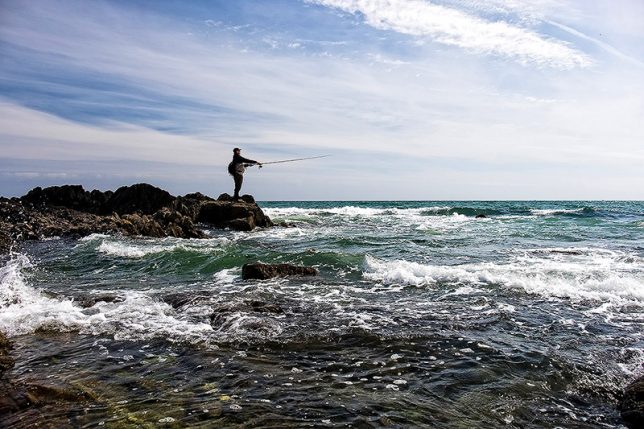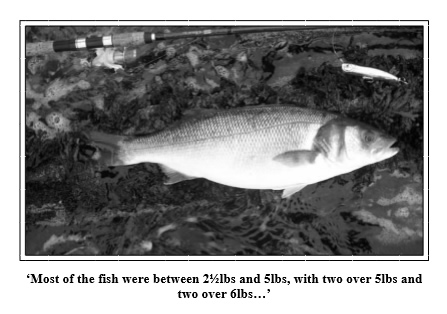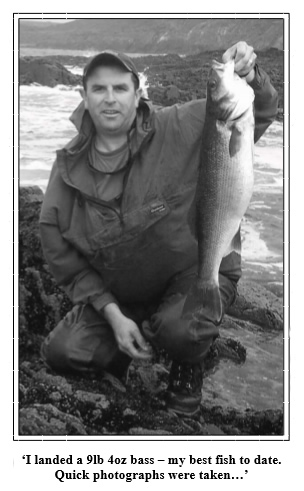CHAPTER 5 – GOOD DAYS, BAD DAYS
New To Plugging
As a comparative newcomer to lure fishing for bass, I experienced a quite remarkable session during a visit to Ireland and would like to share my experiences of that and other trips in the same year.
Apart from a frustrating and fishless fortnight spent plugging during the summer of 1989 (inspired, like many others I suppose, by Ladle and Vaughan’s book Hooked on Bass), 2003 was my first serious attempt at catching bass with plugs.
Having caught a fair number of bass over the years on bait, it is clear to me that the key to success, in any type of bassing, is location, and this applies even more when using plugs. After much reading on the subject and heeding advice from, amongst others, some very helpful B.A.S.S. members, I headed off with a couple of Ordnance Survey maps of north Wales to finally lay the ghost of the Summer of ’89.

I decided on the general area that I wished to explore and after quite a few dead ends, parked the car as tight up to a fence as I could in order to avoid blocking a narrow lane, and set off on what turned out to be a mile-long trek to the shoreline. When I got there it was textbook stuff – rocky, weedy, clear water, a tide rip offshore, and remote – to this day I have only seen one other person fishing there. In one year I caught fifty one bass in twelve sessions from this beach, and only one session was a blank. Most of the fish were between 2.5lb and 5lb, with two over 5lb and two over 6lb (heaviest 6lb 9oz). Not big fish by the standards of others, but a success story for me. Most of the fish were taken on a Duel Aile Magnet (mostly the green mackerel pattern), the others being taken on Big Bugs, a Chico Boca and a Bridun Lance. There was a bonus fish of a 2lb 8oz sea trout taken on a Dexter Wedge and quite a few mackerel. I also lost another sea trout of around 4lb when it threw the hook during a spectacular leap.
For those who are interested in tackle, I use a ten foot spinning rod, a 4000 size fixed spool reel, 20lb braid and about a metre of 25lb fluorocarbon connected to the braid by a small but strong modified Albright knot. I suspect you will think this excessive but my reasons will become clear.
Strangely, the only time that fish don’t seem to be interested at this mark is at high water during the day (they will readily take a popper at high water at dusk, a matter of inches from the shore). They take freely at all other times and under all conditions, even bright, sunny conditions, ebb, flood, slack water, calm or windy.
 I suppose that the message is, to those who at first, like me, did not succeed with plugs and who perhaps, like I did, doubt the ability of those ‘bits of plastic’ to catch bass, persevere and find a mark where you will catch fish. Basically, that’s it. I suspect that there is no mystique to plugging, but what I am sure of is that to be successful it involves a lot of research and even more application. Which brings me nicely to a special session I had in Ireland.
I suppose that the message is, to those who at first, like me, did not succeed with plugs and who perhaps, like I did, doubt the ability of those ‘bits of plastic’ to catch bass, persevere and find a mark where you will catch fish. Basically, that’s it. I suspect that there is no mystique to plugging, but what I am sure of is that to be successful it involves a lot of research and even more application. Which brings me nicely to a special session I had in Ireland.
Having read about Irish bass fishing since I was a child, it was always an ambition of mine to go – Ian Morris’s article (Once you pop you just can’t stop!) tipped the scales and in early September I found myself in Ireland with my new-found confidence as a lure angler. I was a bit concerned about the small, dropping tides expected during that week, but an email from a B.A.S.S. member who knew the area assured me that the fishing was good. My doubts were dispelled.
My first day started well with four bass of 1lb 15oz, 3lb 8oz, 4lb 12oz, and a beauty of 8lb 10oz, all to the Duel Aile Magnet. The following two days saw the onshore breeze drop to nothing and the calm sea produced just three bass of 3lb, 4lb, and 4lb 2oz, to either the Duel or a Chico Boca, but it was my final day and the smallest tide that produced something special.
I got down to the beach for low water at 7.00 am. There was quite a bit of cloud cover and the onshore breeze had returned – conditions looked perfect. However, I fished hard along the length of the beach for two hours without any sign of a fish. I was beginning to think that perhaps it just wasn’t going to happen, when at about 9.30am I jumped over a gully and onto the rocky spit where I had caught the 8.10 fish at the beginning of the week. I looked down and in the water were thousands of herring fry. They were everywhere; in the gullys behind me, stranding themselves on the ledge that I was standing on, coming in four and five at a time on the trebles of the popper that I was using. Then the mackerel arrived, launching themselves into the baitfish just feet from the shore. Then the bass arrived, giving themselves away by their bronze gill covers as they took either the herring fry or the mackerel off the surface. Then the gulls arrived, wheeling and screaming and diving, totally oblivious of the fact that I was in the midst of them all. I persevered with the Aile Magnet for a further five minutes to no avail as this primeval drama continued to take place all around me.
Removing the popper, I clipped on a very small, silver, jointed minnow-type plug in an attempt to ‘match the hatch’, but this only resulted in a mackerel a cast. I was now beginning to get desperate, not wanting to lose this wonderful opportunity on my last day’s fishing. Wondering what to do next, I remembered reading about just this situation in Michael Kennedy’s book Salt-Water Angling written in 1956:
‘… when bass, mackerel or pollack are smashing into large shoals of sprats, herring fry or sandeels a lure which closely imitates one of these bait fishes becomes merely one silver flickering “small—fry” amongst thousands of actual small-fry, and as there is no reason why it should be singled out for attack, its chance of being taken becomes a lottery chance. Under such conditions, a lure suggestive of the small fry on which the fish are preying, but much larger, stands a much better chance of being taken alternatively a lure in no way resembling the small fry, but with an intriguing action, might be tried.’
OK I thought, they want large/intriguing, I’ll give them large/intriguing, and I clipped on a blue/chrome Saltwater Big Bug and cast out about twenty yards. Three chugs and bang! A fish took the Bug with an almighty splash and took off. It was a good fish and fought hard all the way into a deep gully directly in front of me where it surfaced and turned on its side, beaten. At that moment, the 14lb fluorocarbon parted about six inches above the lure and off swam the bass before I could make a grab for it. It was at this moment that I decided never to use anything less than 25lb fluorocarbon or clear mono for a leader to the plug. It isn’t so much the losing of a good fish that bothers me, it’s more the fact that I really hate the thought of a fish swimming away with a lure attached to its mouth. I intend not to let that happen again if I can help it. What made it even worse is that I had had that particular brand of 14lb fluorocarbon break on me twice before, for no apparent reason, on two 6lb—plus fish (both of which I managed to land) so I should have known better. As far as I am concerned, the object is to land the fish safely, and if it is to be returned in good condition then the more quickly it is landed the better. Consequently, I have some serious misgivings about fishing too light for bass, especially over rough ground.
 Back to the rocky spit. By now the breeze had picked up, resulting in quite a lively sea state creating some white water close in. Still annoyed at myself for losing that fish, I tipped several plugs onto the ground to see what was left. No more big bugs, but I spotted a brand new Smith Zipsea Pop Silver Fry still in its box. This is a beautifully made silver popper with a red dished front and is about the size of the Aile Magnet. Perfect I thought, suggestive of the fry, and larger, so on it went and out I cast. The lively sea was making it difficult to work a smallish popper effectively, and after about six casts the Zipsea was picked up by an incoming wave and was being carried shoreward. What happened next is a sight that I shall never forget. As the lure was carried in, a very large bass powered through the clear, green water of the curl of the breaking wave and grabbed the plug – what a fantastic sight! It was all over in a split second but at the time it seemed like slow motion. After a great fight which consisted of four or five powerful runs in the choppy sea, I landed a 9lb 4oz bass – my best fish to date. Quick photographs were taken and the fish was released, taking a couple of minutes to recover before swimming away into the by now churning sea.
Back to the rocky spit. By now the breeze had picked up, resulting in quite a lively sea state creating some white water close in. Still annoyed at myself for losing that fish, I tipped several plugs onto the ground to see what was left. No more big bugs, but I spotted a brand new Smith Zipsea Pop Silver Fry still in its box. This is a beautifully made silver popper with a red dished front and is about the size of the Aile Magnet. Perfect I thought, suggestive of the fry, and larger, so on it went and out I cast. The lively sea was making it difficult to work a smallish popper effectively, and after about six casts the Zipsea was picked up by an incoming wave and was being carried shoreward. What happened next is a sight that I shall never forget. As the lure was carried in, a very large bass powered through the clear, green water of the curl of the breaking wave and grabbed the plug – what a fantastic sight! It was all over in a split second but at the time it seemed like slow motion. After a great fight which consisted of four or five powerful runs in the choppy sea, I landed a 9lb 4oz bass – my best fish to date. Quick photographs were taken and the fish was released, taking a couple of minutes to recover before swimming away into the by now churning sea.
I believe that the general rule when plugging is to keep moving but there was no way that I was going anywhere! Fifteen minutes later a fish of 5lb was hooked and landed and fifteen minutes after that another of 6lb fell to the little silver Zipsea. By this time the large gully behind me was rapidly filling, and I knew I had about another fifteen minutes before I would be cut off. Working the Zipsea, it was taken in a quiet swirl by a large fish close in which powered away on five searing runs, stripping a lot of line off the reel and staying deep. After what seemed like an age, the bass finally arrived in the deep gully in front of me, hugging the bottom, still not having shown itself. As it started on a sixth run, I decided to try and hold it (why I don’t know), then everything went slack and up to the surface came the popper. Because it had stayed deep I didn’t get a look at it but it felt much more powerful than the 9lb 4oz fish. I put losing that bass down to my lack of experience in playing large fish on plugging gear, perhaps putting too much pressure on it close in when using braid, which of course is very unforgiving. I also find the hooks on the Zipsea Pop to be a little on the small side. Oh well, it’s all a learning curve isn’t it?
As I got off the rocky spit and waded across the gully onto the beach proper, I seemed to be jumping back into the real world. The gulls, herring fry, mackerel and bass had all gone. The cloud cover had lifted. I was standing in brilliant sunshine with a clear blue sky overhead. Had it really happened? Of course it had. Three large bass caught (one being my personal best fish) and two large fish hooked and lost (was one of them the elusive double?), all within the space of sixty minutes is incredible fishing. And you have to remember that all this had happened to a guy who, not so long ago, had not caught a bass on a plug!
I returned to Ireland a month later with a view to testing a Big Bug with a tail section added (as described in ‘The Shy Followers’) and caught fish of 3lb 10oz, 6lb 8oz, and 8lb 6oz, on the modified plug – as well as losing a big fish (yes another!) in a dense kelp bed. Thanks Allan, for sharing that idea with the rest of us. Why didn’t I think of that? I guess that’s the difference between a thinking, innovative angler and me.
Well there you have it. I hope my story will encourage you to stick at it if you are not having much success. I did, but then I’m a focused sort of person, but I also know that my success is also down to advice and encouragement from B.A.S.S. members who take the trouble to help others and who write such informative articles for the B.A.S.S. magazine.
Author: Leigh Davies
Historical note: This article first appeared in BASS magazine no.110 Summer 2004.
© Bass Anglers’ Sportfishing Society 2008